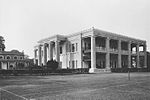
Sri Anandamoyi Ma, early 20th century Hindu religious figure
Shahbag is populated by mostly teachers and students, and its civic life is dominated by the activities of its academic institutions. Its commercial life too reflects its occupants' intellectual and cultural pursuits. Among its best known markets is the country's largest second-hand, rare, and antiquarian book-market,consisting of
Nilkhet-Babupura Hawkers Market, a street market, and
Aziz Supermarket, an indoor bazaar. Shahbag is also home to the largest flower market (a street side open air bazaar) in the country, which is located at Shahbag Intersection, as well as the largest pet market in the country, the
Katabon Market. In addition, Elephant Road features a large shoe market and,
Nilkhet-Babupura, a large market for bedding accessories.
Shahbag's numerous ponds, palaces and gardens have inspired the work of artists, including poet Buddhadeva Bose, singer Protiva Bose, writer-chronicler Hakim Habibur Rahman, and two Urdu poets of 19th century Dhaka, Obaidullah Suhrawardy and Abdul Gafoor Nassakh. Shahbag was at the centre of the cultural and political activities associated with the Language movement of 1952, which resulted in the founding here of the Bangla Academy, a national academy for promoting the Bengali language. The first formal art school in Dhaka – the Dhaka Art College (now Faculty of Fine Arts) – was founded in Shahbag by Zainul Abedin in 1948. Later, Mazharul Islam, the pioneer of modern architecture in Bangladesh, designed the art college as one of his early projects. In the 1970s, Jiraz Art Gallery opened as the first commercial art wing in the Shahbag area. Other cultural landmarks in the area include the Bangladesh National Museum, the National Public Library, and the Dhaka University Mosque and Cemetery, containing the graves of Kazi Nazrul Islam, the national poet, of painters Zainul Abedin and Quamrul Hassan, and of the teachers killed by Pakistani forces during the Bangladesh Liberation War of 1971.
The Shahbag area has a rich religious history. In the late 1920s, Sri Anandamoyi Ma, the noted Hindu ascetic, also known as the Mother of Shahbag, built herashram near Ramna Kali Mandir, or the Temple of Kali, at Ramna. Her presence in Dhaka owed directly to Shahbag, for her husband, Ramani Mohan Chakrabarti, had accepted the position of caretaker of Shahbag gardens a few years earlier. In 1971 the Temple of Kali was destroyed by the Pakistani Army in the Liberation War of Bangladesh.A well-known local Muslim saint of the early 20th century was Syed Abdur Rahim, supervisor of the dairy farm established by Khwaja Salimullah, the Nawab of Dhaka, at Paribag. Known as the Shah Shahib of Paribag, Abdur Rahim had his khanqah (Persian: خانگاه, spiritual retreat) here; his tomb lies at the same location today. Katabon Mosque, an important centre for Muslim missionaries in Bangladesh, is located in Shahbag as well. In addition, the only Sikh Gurdwara in Dhaka stands next to the Institute of Modern Languages in Shahbag.
Since 1875, the Shahbag gardens have hosted a famous fair celebrating the Gregorian New Year and containing exhibits of agricultural and industrial items, as well as those of animals and birds. In the late 19th and early 20th centuries, the gardens were the private property of the Nawab of Dhaka, and, although a portion of the gardens had been donated to Dhaka University in 1918, ordinary citizens could enter the main gardens only during the fair. In 1921, at the request of the Nawab's daughter, Paribanu, the organisers of the fair set aside one day during which only women were admitted to the fair, a tradition that has continued down to the present. Today, the fair features dance recitals by girls, Jatra (a native form of folk theater), putul naach (puppet shows), magic shows and Bioscope shows. Historically, Shahbag was also the main venue in Dhaka for other recreational sports like Boli Khela (wrestling) and horse racing.
The Basanta Utsab (Festival of Spring) takes place every 14 February—the first day of spring, according to the reformed Bangladeshi Calendar. Basanta Utsabhas become a major festival in Dhaka since it was first celebrated in Shahbag in the 1960s. Face painting, wearing yellow clothes (signifying Spring), music, and local fairs are typical of the many activities associated with the festival, which often also includes themes associated with Valentine's Day.
Shahbag is also a focal point of the Pohela Baishakh (the Bengali New Year) festival, celebrated every 14 April following the revised Bengali Calendar, and now the biggest carnival in Dhaka.From 1965 to 1971 the citizens of Dhaka observed the festival as a day of protest against the Pakistani regime. Other local traditions associated with the festival include the Boishakhi Rally and the Boishakhi Mela begun by the Institute of Fine Arts (now Faculty of Fine Arts) and the Bangla Academy respectively. In addition, Chayanaut Music School began the tradition of singing at dawn under the Ramna Batamul (Ramna Banyan tree). In 2001, a suicide bomber killed 10 people and injured 50 others during the Pohela Baishakh festivals. The Harkat-ul-Jihad-al-Islami, an Islamic militant group, was alleged to be behind the incident.
Books and movies figure prominently in the cultural life of Shahbag. The biggest book fair in Bangladesh is held every February on the premises of the Bangla Academy in Shahbag. The only internationally recognised film festival in Bangladesh—the Short and Independent Film Festival, Bangladesh—takes place every year at the National Public Library premises. The organisers of the film festival, the Bangladesh Short Film Forum, have their offices in Aziz Market. Aparajeyo Bangla, a sculpture in memory of Bangladesh Liberation War, is also in Shahbag.




























